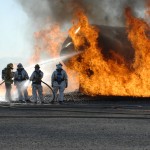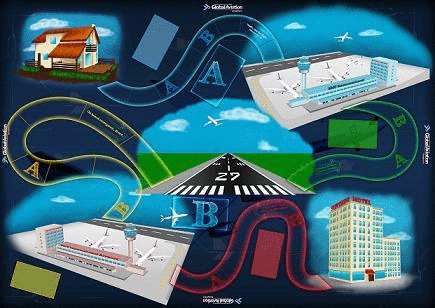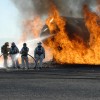Fire
[audio:https://aviationenglishblog.com/wp-content/uploads/2010/10/01fire.mp3|titles=Fire]TOPIC: Fires
GOAL: To learn Aviation English vocabulary related to the dangers of aircraft fires and their causes.
Exercise #1: Read about aircraft fires, and then proceed to Exercise #2
Perhaps few things are as scary as an aircraft fire. They are serious business because, unlike an automobile, pilots don't have the luxury of stopping their aircraft in flight to solve the problem. Reacting quickly and correctly is essential to effectively deal with the emergency. When a fire erupts, you may have little time to consult the emergency checklist, and if you're confused or uncertain about the procedures, your reactions may be slow and inappropriate.
There have been several well-known cases of aircraft fires, including a UPS DC-8 that burned-up after it landed at the Philadelphia International Airport in 2006. Another classic scenario occurred during the tragic accident of ValueJet Flight 592 which crashed into the Florida Everglades after an in-flight fire developed shortly after departure.
 Pilots can face four types of aircraft fires — fires during engine start, electrical fires, in-flight engine fires, and post-crash fires. It's important that you understand the proper checklist procedures for each type and the reasons behind the checklist items.
Pilots can face four types of aircraft fires — fires during engine start, electrical fires, in-flight engine fires, and post-crash fires. It's important that you understand the proper checklist procedures for each type and the reasons behind the checklist items.
Starting a fire is a matter of combining fuel, air, and an ignition source, so removing one of these ingredients will extinguish it. Most emergency checklists try to do exactly that, but the checklist is also designed to help minimize damage, deal with the smoke, and get the aircraft on the ground quickly and safely. The cockpit voice recorder transcript from the Valuejet crash provides us an example of how quickly an in-flight fire can spread to deadly levels.
 A fire is more likely to occur under the cowl when a component fails because of age, fatigue, or improper maintenance. An overheated turbocharger or a crack in the exhaust system or a cylinder can ignite the spray from a broken fuel or oil line to create a fiery blaze.
A fire is more likely to occur under the cowl when a component fails because of age, fatigue, or improper maintenance. An overheated turbocharger or a crack in the exhaust system or a cylinder can ignite the spray from a broken fuel or oil line to create a fiery blaze.
Electrical power from alternators, generators, and batteries constitutes another potential heat source. With power routed to virtually every part of the aircraft for lighting, deicing, radios, landing gear and flap motors, and fuel pumps, the electrical system is another prime candidate for starting fires. Insulation, adhesives, and fabrics make great fuel for fire, as does the insulation on the wiring itself. Leaking fuel from a primer or fuel-flow gauge, or dripping fluid from a brake cylinder are also excellent fuels that an electrical spark can ignite.
Although the engine and electrical system constitute the primary ignition sources, they aren't the only causes of fires. On ValuJet flight 592, oxygen canisters bumped into each other, ignited and the fast-spreading fire caused that fatal crash.
Exercise #2: Watch two videos about aircraft fires:
- An inside look at a aircraft fire simulator VIDEO
- Dramatic footage of a China Airlines B737 on fire VIDEO
Exercise #3: Answer the following questions, which are based on the information contained in the text and videos you’ve just studied.
1. Pilots can face four types of aircraft fires — fires during engine start, electrical fires, in-flight engine fires, and______?
- engine shutdown fires
- post-crash fires
- liquid fires
- none of the above
2. Which of the following crashed into the Florida Everglades after an in-flight fire developed shortly after departure?
- A UPS DC-8
- Air Florida Flight 292
- Valuejet Flight592
- A China Airlines B737
3. A fire is started by combining:
-
- fuel, air, and an ignition source
- fuel and air
- fuel and heat
- none of the above
4. True or False: A fire is more likely to occur under the cowl when a component fails because of age, fatigue, or improper maintenance.
- True
- False
5. ________ is essential to effectively dealing with the emergency.
- Calling air traffic control
- Reacting quickly
- Reacting correctly
- Both B and D are correct.
6. Electrical power from alternators, generators, and ______ constitutes another potential heat source.
- batteries
- headsets
- avionics
- lights
7. An overheated turbocharger or a crack in the ______ system or a cylinder can ignite the spray from a broken fuel or oil line.
- fuel
- battery
- exhaust
- braking
8. According to the first video you saw, the materials inside an aircraft cabin can be very ______ when burned.
- toxic
- hot
- adhesive
- none of the above
Answers: 1-b, 2-c, 3-a, 4- true, 5-d, 6-a, 7-c, 8-a
















excellent!!
Great arclite, thank you again for writing.
To whom it may concern:
Hi My name is Ronaldo and I am intrested in becoming a pilot in the future and I would like to learn english for pilot as english is not my first language I would like to know if is possible for me to download this material?
Do I need to ask permition? if so, to whom?
I will appreciate any help you can provide me.
kind regards